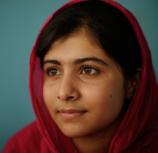I Am Malala: The Girl Who Stood Up for Education and Was Shot by the Taliban
Review
I Am Malala: The Girl Who Stood Up for Education and Was Shot by the Taliban
Like most Americans, I had never heard of Malala Yousafzai until the horrible news story of October 2012, which reported that a young Pakistani girl had been shot in the face by the Taliban because of her activism for girls’ education. Over the next few days and weeks, we learned that she had been moved to England for treatment. More recently, she was in the news again as a nominee for the Nobel Peace Prize. Yet her fascinating autobiography shows us not only the brave and committed activist, but also a fun-loving girl who loves to win at school, fights with her brothers, and is devoted to her family, homeland and Muslim faith.
The prologue is a brief description of the day of the shooting. The family was aware of threats against her life and her father’s life, but Malala says she doubted they would really attack a school girl: “Like my father, I’ve always been a daydreamer, and sometimes in my lessons my mind would drift and I’d imagine that on the way home a terrorist might jump out and shoot me on those steps. I wondered what I would do. Maybe I’d take off my shoes and hit him but then I’d think if I did that there would be no difference between me and a terrorist. It would be better to plead, ‘OK, shoot me, but first listen to me. What you are doing is wrong. I’m not against you personally, I just want every girl to go to school.’”
"As I read this fascinating book, I marveled at how much history this young woman has seen and now shared with us. A moving story in its own right, I AM MALALA also provides a framework for the bits and pieces we hear on the news."
Malala’s story begins with the day of her birth and the family and culture into which she was born. Although traditional Pashtuns don’t celebrate the birth of daughters, her father was different. He named her after Malalai of Maiwand, the greatest heroine of Afghanistan, and asked friends to throw dried fruits, sweets and coins into her cradle, something that is usually reserved for boys. We learn about the history of the Swat Valley, which became part of Pakistan in 1947 when the British gave India independence and divided it into two countries. We also learn of its beauty: “We have fields of wildflowers, orchards of delicious fruit, emerald mines and rivers full of trout.” Malala’s father started a school in Mingora, the largest city in the Valley: “He believed that lack of education was the root of all of Pakistan’s problems.” Malala’s mother started school at age six and quit the same term. Her father didn’t even notice.
“I was ten when the Taliban came to our valley. Moniba and I had been reading the Twilight books and longed to be vampires. It seemd to us that the Taliban arrived in the night just like vampires.” Soon her father was under pressure to separate boys and girls in his school, and he complied. Then came the advice to have only women teach the girls. In the valley, most of the news came via radio, since many had no TV or were illiterate. A man named Fazlullah started a radio program, introducing himself as an Islamic reformer and interpreter of the Quran. Fazlullah became known as the Radio Mullah, and the edicts grew: “Within six months people were getting rid of their TVs, DVDs and CDs. Fazlullah’s men collected them into huge heaps on the streets and set them on fire, creating clouds of thick black smoke that reached high into the sky.”
The tension and pressure built as the Taliban gained power in the Swat Valley, and day by day some people, like Malala’s family, resisted and ultimately paid a very high price. As I read this fascinating book, I marveled at how much history this young woman has seen and now shared with us. A moving story in its own right, I AM MALALA also provides a framework for the bits and pieces we hear on the news. Just a few days ago, the hardliner Fazlullah was elected leader of the Pakistan Taliban, endangering peace talks between the government and the Taliban. Meanwhile, Malala and her family are exiled in Birmingham, England. I hope, as she does, that someday she can return to the country she loves and make a difference.
Reviewed by Eileen Zimmerman Nicol on November 15, 2013
I Am Malala: The Girl Who Stood Up for Education and Was Shot by the Taliban
- Publication Date: June 14, 2016
- Genres: Nonfiction
- Paperback: 256 pages
- Publisher: Little, Brown Books for Young Readers
- ISBN-10: 0316327913
- ISBN-13: 9780316327916






